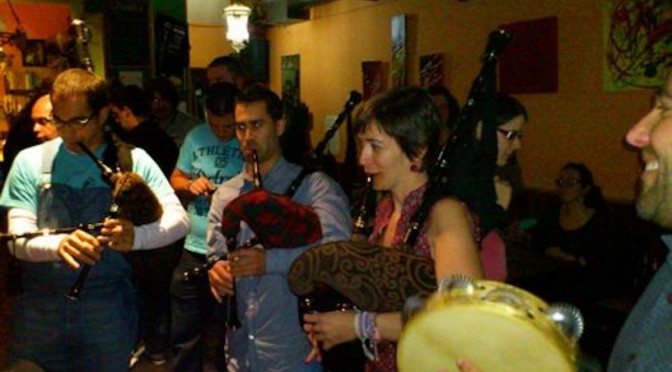In 2008 I was in a Pyrenean Ski resort enjoying the atmosphere of a crowded bar. The choice of music, which fearured bagpipes, drums and a small harp, giving an almost gaelic feel to the evening. Suddenly I realised that the conversation bouncing around me was not French but Occitan!
For those who visit the area it is probably enough to say that the inhabitants of Occitan are unique vibrant and proud.
Ethnicity
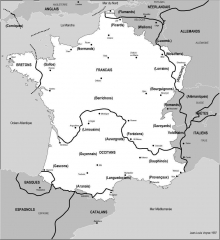 Ximene has a legitimate claim to much of what is now the departement of Languedoc Rousillion in Southern France. The claim was in fact less than one half of the area, which could clain a unique identity under the name of Occitan.However, nothing about ethnicity should be taken as fact. Linguists, historians, archeologists, DNA scientists and cultural analysts all identify differing cultural and ethnic groupings within the boundaries of modern France. They are often pursuing studies of isolated segments of the total picture without too much cross reference to other disciplines.
Ximene has a legitimate claim to much of what is now the departement of Languedoc Rousillion in Southern France. The claim was in fact less than one half of the area, which could clain a unique identity under the name of Occitan.However, nothing about ethnicity should be taken as fact. Linguists, historians, archeologists, DNA scientists and cultural analysts all identify differing cultural and ethnic groupings within the boundaries of modern France. They are often pursuing studies of isolated segments of the total picture without too much cross reference to other disciplines.
The net result that is that there are significant differences of opinions.
Language
Language has traditionally been used to distinguish between different peoples and different ethnicities.
There are four major languages which emphasise the differences in what is now France; Breton, Basque, Francais (Langues d’Oil) and Occitan (Langues d’Oc).
Breton is a Celtic language with strong similarities with Cornish and Welsh, It is generally accepted that the Bretons arrived from Cornwall and that they were Atlantic Celts fleeing from the Anglo Saxon invasion of Britain.
Français is basically a German, not Celtic language. Le Francais (Langue d’Oil) was derived from Frankish influenced by Latin but there are hundreds of words which linguists consider to be Celtic, which passed into French after first being being absorbed into the form of Vulgar Latin spoken in Northern France.
In a similar way Occitan (Langue dOc) is derived from Latin but the non Latin roots are not Germanic or Celtish, but some other Language, possibly Basque.
However just to complicate matters there are speakers of an Occitan dialect in Northern Italy and in the Val d’Arana in northern Spain. There are strong similarities to the Catalan language and culture of North Eastern Spain.
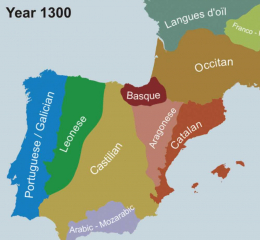 The Basque Language is somewhat of a mystery. It has no common roots with any other European language. Basque is important as it is still spoken in Navarre, Southern Aquitaine and Bearn, and may be the ancestor of Langues d’Oc.
The Basque Language is somewhat of a mystery. It has no common roots with any other European language. Basque is important as it is still spoken in Navarre, Southern Aquitaine and Bearn, and may be the ancestor of Langues d’Oc.
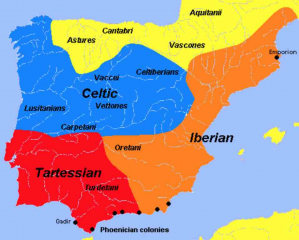
One theory is that with the onset of the Ice Age, what is now the Basque country, Aquitaine and Occitanie became a refuge for an earlier people driven south. They spoke a language (called here Aquitainii) spoken on both sides of the Pyreneees. This language was not Indo-Euopean. Two other languages; Iberian and Tartessian were also pre Indo-European.
These languages were still spoken at the time of the Roman invasion but at that time in the middle of the Iberian peninsula there were Celtic Tribes including the Lusitanians who did speak an Indo- European language.
There is much discussion, but no agreementas to wether Aquitanii is a precursor to Basque or a devevelopment of it.
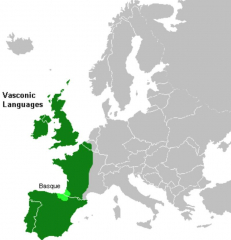 There is an alternative view that the Aquitanian language was actually an extension of a Vasconic language which extended over the whole of the atlantic seabord . Again the therory is that those who spoke this language were diven south by the ice and subsequently west by the arrival of a new wave of settlers. Both these theories have Occitan as a derivative of a pre-ido european language,
There is an alternative view that the Aquitanian language was actually an extension of a Vasconic language which extended over the whole of the atlantic seabord . Again the therory is that those who spoke this language were diven south by the ice and subsequently west by the arrival of a new wave of settlers. Both these theories have Occitan as a derivative of a pre-ido european language,
What seems to be certain is that the Basque language or it’s predecessors once covered a much bigger area. Basque must have survived undiluted in the Western Pyrenees and along the coast of the Bay of Biscay because, whatever the history books say, it was never absorbed into the Roman Empire. Basque has gradually retreated to this relatively small area at the base of the Western Pyrenees
What all these thories have it in common that the language spoken in Aquitaine, Occitan and Provence and therefore the ethnicity of it’s people is completely different.
Dialects
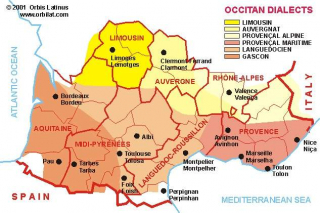 Greater Occitan could be subdivided into provinces according to the dialect of the Occitan language spoken in each districtIt is a feature of well established languages that there are discernible dialects. Much of the modifiation occurred during the time of the Roman empire but accelerated when there was no need for uniformity across the Empire.
Greater Occitan could be subdivided into provinces according to the dialect of the Occitan language spoken in each districtIt is a feature of well established languages that there are discernible dialects. Much of the modifiation occurred during the time of the Roman empire but accelerated when there was no need for uniformity across the Empire.
There are at least seven dialects of Occitan.
The Celts
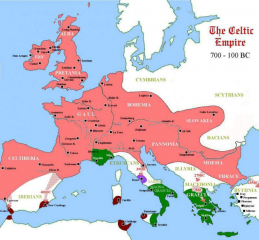
50 years ago when the other source of determination of ethnicity was archeologists. it was generally assumed that after the demise of the pre Indo-Europeans , Celtic civilisation covered the whole of mainland europe with the small exceptions of Etruscans, Romans, Carthagenians and Greeks. However this diagram, though drawn from a site promoting celtic heritage shows the significant greek (Magna Greacia) presence in what today is Provence-Alpes-Cote d’Azur (PACA).
The Celts are popularly believed to have sprung from a people from Hallstatt in Austria. Conclusions about their spread are still mainly based on the archeological discovery of Celtic artefacts in the areas shown.
Differences in the syle of artefacts discovered indicate different cultures , such as the “Hallstadt” or “La Tene” cultures, often defined by differing styles of building, burial, jewellery or domestic utensils.
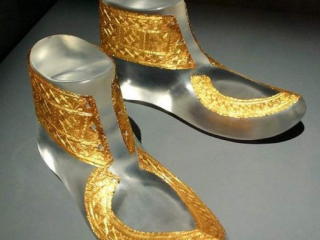 Traditionally investigations of various tribes or peoples has concentrated on archeological discoveries which in themselves lead to the identification of specific cultures, such as the "Hallstadt" or "La Tene" cultures, often defined by styles of building, burial, jewellery or domestic utensils.
This illustration has been chosen as I think it gives a totally different perspective on who the “ la Tene” people were. These are not “shoes” they are 'foot decoration'. Incredibly they have something in common with our images of Egypt.
Language is also considered important. Identification of language spoken and the group of languages the language belongs to can used to define "race". It is for this reason that the somewhat academic identification of the Ino european language grouping got mixed up with Hitler's Ayrian master race and the continuing fascination with white supremacy.
On the other hand a lot of the genetic work currently being carried out in India is both racially and politically inspired. The may not recognise it in these terms but they want to establish Indian racial supremacy and deny that any Ayrian "invasion" of India every took place. They don't believe the Indo euopean language came to india but that india was the source of both language and civilisation for the rest of the world and particularly Western Europe.
As the Indian experience shows, more recently DNA studies have come to the fore. The combination of DNA studies and the investigation of haplogroup distribution in regions and countries throughout the world has presented evidence of extensive migrations. These migrations may not have been invasions as such but just a gradual expansion of peoples with identifiable gene configurations into new territories. However each SNP mutations identified is considered to have happened once, in one individual, so the spread of the peoples carrying that mutation into territories already inhabited by other human beings will have inevitably have lead to some ancient wars, unrecorded except for dreamlike memories in ancient fables.
Traditionally investigations of various tribes or peoples has concentrated on archeological discoveries which in themselves lead to the identification of specific cultures, such as the "Hallstadt" or "La Tene" cultures, often defined by styles of building, burial, jewellery or domestic utensils.
This illustration has been chosen as I think it gives a totally different perspective on who the “ la Tene” people were. These are not “shoes” they are 'foot decoration'. Incredibly they have something in common with our images of Egypt.
Language is also considered important. Identification of language spoken and the group of languages the language belongs to can used to define "race". It is for this reason that the somewhat academic identification of the Ino european language grouping got mixed up with Hitler's Ayrian master race and the continuing fascination with white supremacy.
On the other hand a lot of the genetic work currently being carried out in India is both racially and politically inspired. The may not recognise it in these terms but they want to establish Indian racial supremacy and deny that any Ayrian "invasion" of India every took place. They don't believe the Indo euopean language came to india but that india was the source of both language and civilisation for the rest of the world and particularly Western Europe.
As the Indian experience shows, more recently DNA studies have come to the fore. The combination of DNA studies and the investigation of haplogroup distribution in regions and countries throughout the world has presented evidence of extensive migrations. These migrations may not have been invasions as such but just a gradual expansion of peoples with identifiable gene configurations into new territories. However each SNP mutations identified is considered to have happened once, in one individual, so the spread of the peoples carrying that mutation into territories already inhabited by other human beings will have inevitably have lead to some ancient wars, unrecorded except for dreamlike memories in ancient fables.
There is evidence however of some selectivity with regard to the artefacts chosen to illustrate the achievements or level of sophistication of the cultures studied.
The “golden shoes” discovered on one of the “la Tene” sites give a totally different perspective on who the “ la Tene” people were to the image projected by the more common displays of prosaic “la Tene” artefacts.
These are not “shoes” they are ‘foot decoration’.
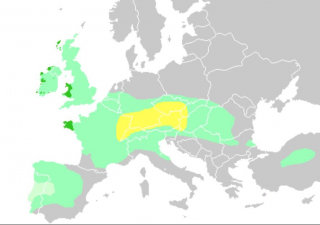 Most mainstream histories still assume that Celts were the dominent thoughout northern europe in the period before the roman invasion.
Most mainstream histories still assume that Celts were the dominent thoughout northern europe in the period before the roman invasion.
Note, however that this more recent graphic does not show the Celts as occupying the area of Aquitaine or Occitaine.
Thus, by this information alone, the peoples of Greater Occitan are different from the French north of the Central Massive.
The Roman View
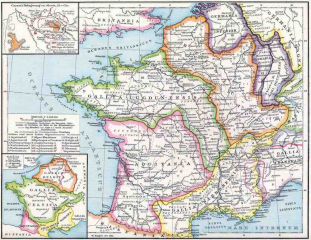 In fact Ceasar himself wrote “Gaul is divided into three parts, one of which the Belgae inhabit, the Aquitani another, those who in their own language are called Celts, in ours Gauls, the third.”
In fact Ceasar himself wrote “Gaul is divided into three parts, one of which the Belgae inhabit, the Aquitani another, those who in their own language are called Celts, in ours Gauls, the third.”
The Roman provinces established to govern these peoples allowed for these differences.
This grapic also shows the area along the mediterranean coastline called Provincia Narbonensis. Caesars gallic wars originated to protect the Greek settlements in this are from celtic attacks.
Later this area became known as “Septimania” because of land grants in the area given to retired soldiers from the Seventh Legion. It includes the areas of both Occitanie and Provence-Alpes-Cote d’Azure (PACA).
Against the Ocean
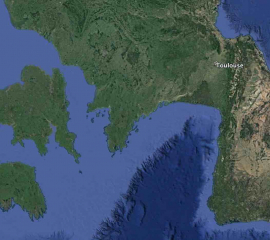
Barry Cunliffe (Barrington Windsor Cunliffe), Emeritus Professor of history at Oxford, has a rather different view expressed in his books Against the ocean and Ancient Celts.
He believes that some Celts origated along the Atlantic coastline and from there spread into the european mainland.
Certainly the view from the Atlantic gives a totally different perspective of the relation of the lands facing the ocean and of the position of Aquitaine and Occitan.
Genealogy
The analysis of Human DNA is a newly emerging science which is in a stage of accelerating growth, due to the fact that the same basic technique can be used for a number of different purposes.
In forensic investigations it can help identify the perpetrator of a crime. In medicine, research showing our genetic make is being linked to a predilection to certain illnesses. It can therefore assist in the cost effective targeting of preventative care.
It can also tell us much about our heritage.
Inheritance
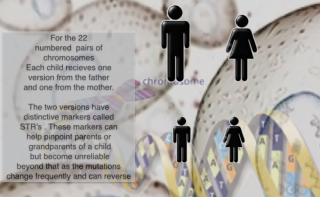
The two versions of DNA inherited from parents have distinctive markers called STR’s (Short Tandem Repeats). A child’s STR pattern will include both the parents STR’s. These markers can help pinpoint parents or grandparents of a child. STR’s however become unreliable beyond that as the mutations change relatively frequently and can reverse.
XY Pairing
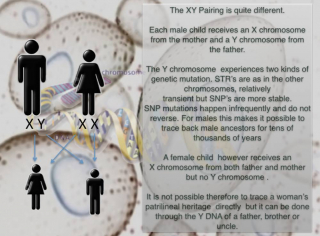
The XY Pairing is quite different. Each male child receives an X chromosome from the mother and a Y chromosome from the father. Over the history of Homo Sapiens, the X and Y chromosomes have experienced two kinds of genetic mutation. STR’s occur as they do in other sections of the DNA, and are similarly relatively transient. In the XY pairing another mutuation occurs SNP’s(Single Nucleotide Polymorphism) or “snips”
Tracing Ancestors
SNP mutations happen infrequently and do not reverse. For males analysis of the structure of the Y chromosome makes it possible to trace back male ancestors for tens of thousands of years and to identify which tribe the person belongs to. The scientific name for “tribe” is Haplogroup.
DNA Discrimination
A female child however receives an X chromosome from both father and mother but no Y chromosome . It is not possible therefore to trace a woman’s patrilineal heritage directly. It can be traced through the Y DNA of a father, brother or uncle, assuming those relationships are firmly established.
Mitochondri
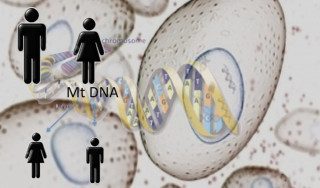
All of us, male and female, also carry, independent of the chromosomes in the nucleus of each cell, a material called Mitochondri. It is the material which enables cells to use the energy generated from food. It has its own independent, stable DNA and it is only inherited from our mothers. The Mitochondri therefore permits the tracing of our matrilineal heritage.
This tracing is possible for both men and women without a need to use relatives as a reference
Tracking our ancestors
Geneologists have, in the twenty-first century, played an increasingly important role in defining ethnicity, supplementing much of the work previosly carried out by archeologists and linguists.
It centers around the distribution of occurances of human mutations in modern populations. It gives an alternative view of themovement of peoples.
Human DNA has mutated many times. starting with Haplogrop A, carried by the ancestors of homo sapiens as they came out of Africa.
The original Haplogroup was called A (for Adam) and all major subsequent mutations have been contained within the twenty six letters of the alphabet
DNA Haplogroup T-An Earlier people
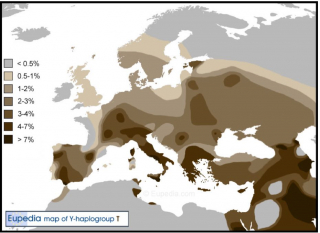 The distribution of Haplogroup T is generaly a good match for the theories of language and the existance of a pre Indo-European people driven south by the ice age. It is strong in the north of Italy, including Etruscan territory. This is interesting as the Etruscan language is also pre Indo -European and shows some features in common with Basque/Aquitanii/Vscones.
The distribution of Haplogroup T is generaly a good match for the theories of language and the existance of a pre Indo-European people driven south by the ice age. It is strong in the north of Italy, including Etruscan territory. This is interesting as the Etruscan language is also pre Indo -European and shows some features in common with Basque/Aquitanii/Vscones.
It is not, however, a good match for Aquitaine, Occitaine and the Basque country. There is a relatively low level of T in this areas, not what would have been expected if this is where the pre Indo-Europeans had founf refuge from the ice age . How can a pre Indo-European language have persisted until the 21st century when there is a low incidence of what is promoted as the pre Indo-European haplogroup ?
It could have been that the pre indo Europeanns (Vascones?) came from a totally different Haplogroup. Y DNA E has been suggested but that is not a good match either.
The Mating Game.
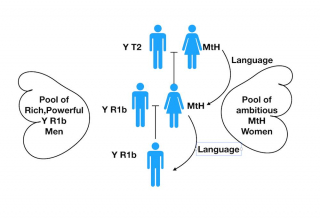
There is another explanation. Women in their search for security for their children will give powerful wealthy men preference. Their children would then be in demand, both male and female, because they had access to influence procured by wealth and power. It is an interesting example of natural selection.
The pattern of the XY chromosome inheritance means that the latest pairing in a genetic chain wipes out all evidence of all earlier pairings.
Assuming that the T1 men were dispossessed or driven out by R1b men, their DNA may be lost but through their woman folk the language could be retained.
In a society where control of sexual activity and family life lay with the women, and that seems to have been true of this area, this is not only possible but probable.
DNA The Dominance of Rb1
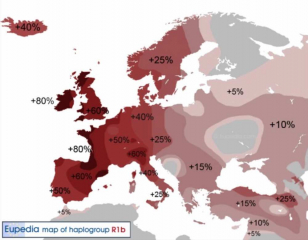
It seems certain that the earlier Haplogroup was displaced by Various mutations of the Rb1 Haplogroup. Rb1 is one of the major genetic mutations in male members of the human race. It is the most common mutation in western europe and in particular on the Atlantic seaboard. At first glance this supports Professor Cunliffe’s theories and at the same time undermines any concept that the peoples of Occitan are in some ways unique. R1b is everywhere!
R1b is however is still a relatively early mutation. There have been many other mutations scince.
DNA ALL R1b 1a 1a 2
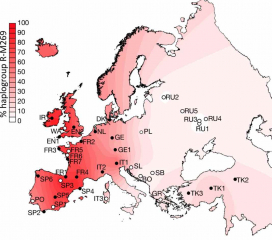
This is an early mutation of R1b which has been gven the name M269. It is spead even more evenly along the Atlantic coast than the total Rib, This mutation is famous for the fact that Tutenkamun may well have been a member of the group sharing it. Again the implication seems to be that there is nothing unique about Occitanie. M269 based genes did occur in Occitan and Aquitaine and the people who shared this gene may well have been the original Atlantic Celts.
DNA The Atlantic Celtic Gene
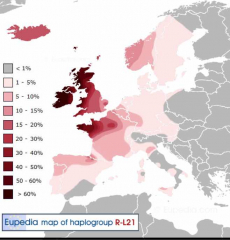
There are however still more subsequent mutations, which when isolated, tell a very different story. L21 is one of these. The chances are that the mutation took place in Northern Ireland. Its ‘long name’ is R1b 1a 1a 2.
Perhaps influenced by the Cunliffe theories genealogists have now identified L21 as the “fingerprint” of Atlantic Celts. This totally changes the picture. There is a very low incidence of this “Celtic gene” in the area of Aquitane and Occitaine.
DNA Longnames
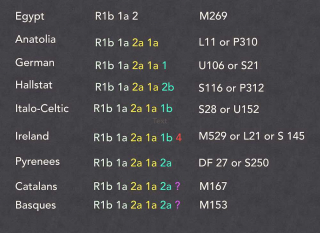
To answer the question , it is necessary to have an understanding of the sequence of mutations.
The original naming convention devised in the late 20th century made it possible to do this. Successive mutations were “tagged onto” the earlier mutation.
Initially the award of seondary titles to regognise the research organisation and the individual researcher who first isolated the mutant gene, was a little piece of scientific arrogance but not serious. It became annoying when competitive laboratories started giving their own name to haplogroups which had already been discovered.
I am not the only person to think that the naming of Haplagroups is now a total misleading mess! Practitioners plead that genealogy is an exact science but the naming conventions are anything but.
In 2006 the first year that ISOGG compiled a SNP tree, the number of Y DNA haplogroups was around 400 not the tens of thousands which have been identified since, No one would ever have believed this SNP tsunami would happen, let alone in such a short time.
CeCe Moore, an independent professional genetic genealogist says:-
“I have to admit that when R1b1b2 was changed to R1b1a2, I just started saying “R1b…whatever” when referring to it. Isn’t it easier to just remember the defining SNP name R-M269?
For example, if you are R-L21+, then according to Family Tree DNA’s Haplotree, you are R1b1a2a1a1b4, the ISOGG 2011 Haplogroup Tree’s name for it. At 23andMe, you are R1b1b2a1a2f in agreement with the 2010 ISOGG Haplogroup Tree.If you tested in 2008, you might still think you are R1b1b2a1b6. On ISOGG’s 2011 Haplogroup Tree , L21+ was R1b1a2a1a1b4, buton ISOGG’s 2012 Haplotree, you are R1b1a2a1a1b3. Apparently, R1b1a2a1a1b4 is now referring to L238/S182! I mean, really, how can anyone keep track? (Ah, for the days of the simple little R tree.) I don’t know how our ISOGG Haplogroup Tree Committee does it anymore! Apparently, the academics are getting tired of it too and it’s just going to get worse when results from Geno 2.0 start rolling in with LOTS of new SNPs and subclades being defined.
Take look at the history of R-M222, the “Ui Niall Subclade”, on just the ISOGG SNP Tree:
2007 = R1b1c7
2008 = R1b1b2a1b6b
2009 = R1b1b2a1a2f2
2010 = R1b1b2a1a2f2
2011 = R1b1a2a1a1b4b
2012 = R1b1a2a1a1b3a1a1Reportedly, Geno 2.0 will define at least three new subclades beneath M222, but I hear it may be more. Do you think those subclade names might get even longer?”
The above is an extract from an article favouring the use of the short names. which igrores the problem of there being several different short names for the same Haplogroup. The problem with only using the SNP names, which are created by the laboratory which first isolated the gene is the SNP names have no meaning other that giving recognition to the researcher. It is only by having the long names that sequencies of mutations can be deuced. If only the SNP names are used then only the specialists will be able to understand sequencies and there is evidence that they will occasionally get it wrong, perhaps even coming to “politically correct” or “commercially advantageous” conclusions.
All the longnames in this diagram are from the ISOGG naming convention of 2011 not the later versions. It should make no difference as long as all longnames are from the same convention, but there are inconsistencies.
DNA Topographical Interpretaion of the Longnames
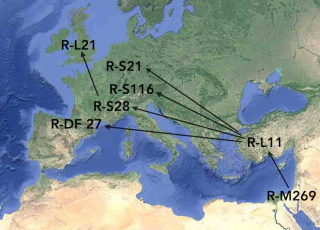 Based on the sequence suggested by the longnames and the distribution found today a sequence of mutations by location can be identified. the fact that the parent gene can also be found throughout western Europe means that the child mutations must have occured in each new location. The diagram shows that there are four different mutations from L11.
Based on the sequence suggested by the longnames and the distribution found today a sequence of mutations by location can be identified. the fact that the parent gene can also be found throughout western Europe means that the child mutations must have occured in each new location. The diagram shows that there are four different mutations from L11.
Only one of these, S28 can be the parent of the L21 Mutation. Thus the Pyrennean mutation M47 has no involvement in the Atlantic Celtic mutation.
DNA The Pyrennean Gene
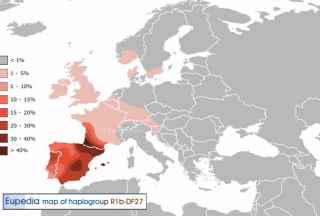 So now it becomes apparent that the area of the Pyrenees is relatively unique genetically furthermore and that they were not the origin of the Atlantic Celt gene. It does not explain the bagpipes!
So now it becomes apparent that the area of the Pyrenees is relatively unique genetically furthermore and that they were not the origin of the Atlantic Celt gene. It does not explain the bagpipes!
DNA The Hallstat Gene
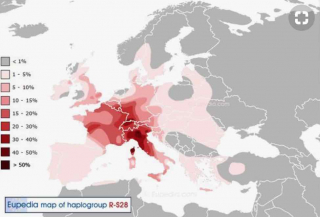 S28, the parent of the Atlantic Celt Gene is in fact the gene which it is considered to be typical od the Hallstat Celts. There is very little occurance of this gene in Occitan
S28, the parent of the Atlantic Celt Gene is in fact the gene which it is considered to be typical od the Hallstat Celts. There is very little occurance of this gene in Occitan
DNA the German Gene
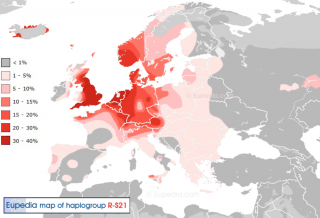 The final child gene of L11 is S 21 kown as the German Gene this gene is found in the Frankish areas of France and inGenetic England taken there by the Anglo- Saxons.
The final child gene of L11 is S 21 kown as the German Gene this gene is found in the Frankish areas of France and inGenetic England taken there by the Anglo- Saxons.
The relatively low incidence of S21 in the most of what is now France confirms previous ideas that the Franks simply took over the Roman state but did not replace it.
Genetic conclusion
Thus from a genetic point of view Occitiane are not only relatively unique, but quite different from the Franks, which is what they claim, proudly and insistantly.
